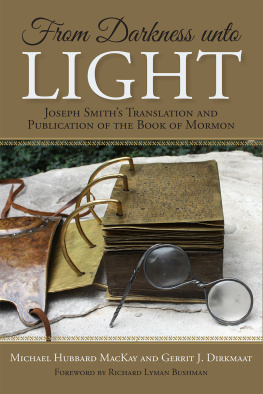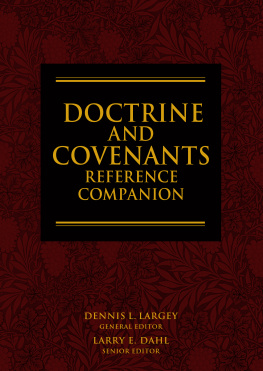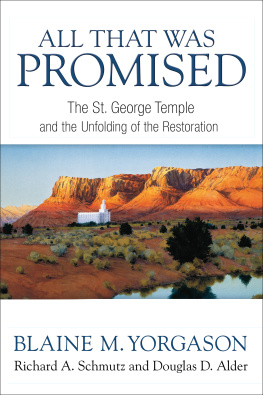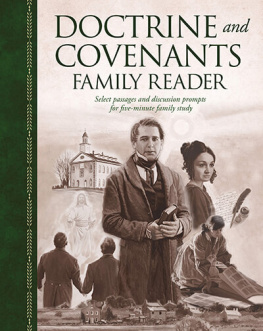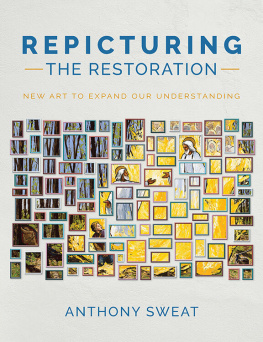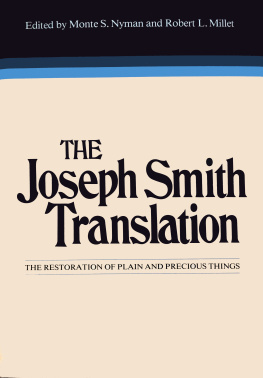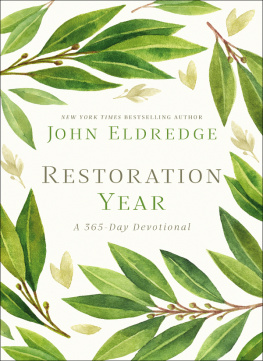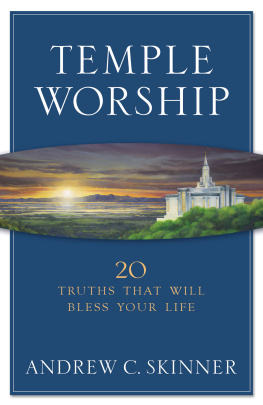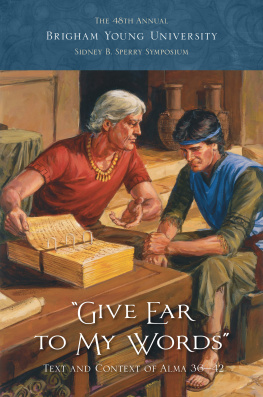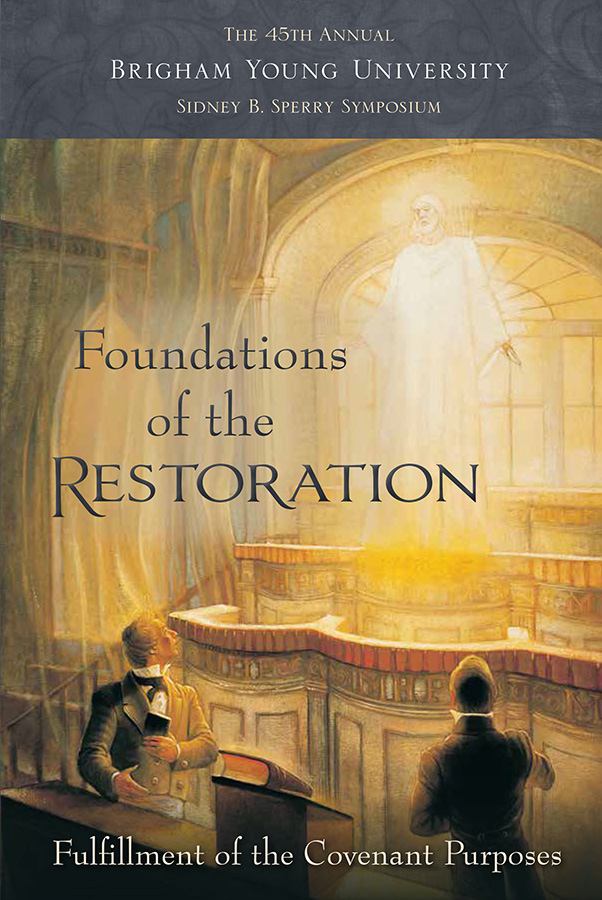Introduction
R eligious educators around the world have begun teaching new curriculum focused on the Restoration of the gospel. Inspired by the new course Foundations of the Restoration, this volume will support teachers and students as they study and teach key events and doctrines of the Restoration. Each article adds to our understanding of various aspects of the Restoration.
Robert L. Millet, former dean of Religious Education at Brigham Young University, who delivered the keynote address at the Sperry Symposium, introduces the Restoration and the Prophet Joseph Smiths role in restoring plain and precious truths. Colleagues Gerrit J. Dirkmaat, Michael MacKay, and Anthony Sweat examine how we evaluate doctrine and propose a model to assist students in their study of doctrinal topics and challenges. Craig Ostler and Lloyd Newell address the historical development of sustaining Church leaders as prophets, seers, and revelators and how these good yet imperfect individuals are inspired in directing the Lords Church.
Other chapters provide answers to questions such as the following: What can the First Vision teach us about the learning process? How do we apply the truths in the Articles of Faith? What did the work of translating the Bible contribute to the Prophet Joseph Smiths understanding of the Restoration? How does the law of consecration continue today? What did early Saints understand regarding Adam-ondi-Ahman, Zion, the gathering of Israel and their place regarding the Second Coming of Christ? What contributions did Church newspaper editor and hymn writer William W. Phelps and Hyrum Smith, the Prophets brother, provide to our understanding of the Restoration? How did temples and temple ordinances develop in the Restoration? What correlations are found in historical understandings of Christian marriage and the doctrine of eternal family as we face new challenges to marriage in the culture of the twenty-first century? And how does restoration of true Sabbath worship affect our lives today?
We are happy to offer this volume to students of the Restoration. We trust that it will inspire and inform your understanding of the gospel of Jesus Christ and the history of the Saints that have accepted the Saviors call to gather to his fold.
Craig James Ostler
Michael Hubbard MacKay
Barbara Morgan Gardner
Patty Smith
Beverly Yellowhorse
2016 Sperry Symposium Committee
The Morning Breaks
The Glorious Light of Restoration
Robert L. Millet
Robert L. Millet is a professor emeritus of ancient scripture and former dean of Religious Education at Brigham Young University.
J esus and the Apostles spoke of the coming of the end of an age, the end of the dispensation of the meridian of time. There would come a day, they warned, when men and women would not endure sound doctrine (2 Timothy 4:3), a day when malicious persons would seek to interject damnable heresies (2 Peter 2:1) into the faith.
Though the political empire of Alexander the Great did not survive his death in 323 BC, the cultural empire he founded lasted for nearly one thousand years, until the rise of Islam and the Arab conquests in the seventh century. Greek or Hellenistic influence was profoundon the Roman empire, on the world of Judaism, and, unfortunately, on the early Christian Church. As Zenos had foreseen, for a time the grafting of branches from the wild olive tree (Gentile influence) would result in a season of strength for the Church (see Jacob 5:17). But it was only a matter of time before the teachings of the prophets and ideas of the philosophers would come in conflict; those with eyes to see were aware that attempts to merge the doctrines of the temple of God with the doctrines of Plato would be abortive to the Christian faith. Ecumenism would lead to shared impotence. Philosophical error, mixed with truth, resulted in a heretical hybrida conceptual concoction foreign to the spiritually sensitive and certainly offensive to that God who delights in revealing himself to his children.
Certainly there were good and noble souls who enjoyed and hearkened to that influence we know as the Light of Christ; they strove to live according to the best light and knowledge they possessed. Having discussed the flickering and dimming of the flame of Christian faith, President Boyd K. Packer stated, But always, as it had from the beginning, the Spirit of God inspired worthy souls. We owe an immense debt to the protesters and the reformers who preserved the scriptures and translated them. They knew something had been lost. They kept the flame alive as best they could.
Elder Alexander B. Morrison of the Seventy wrote, The view that changes in the early church resulted in the dissent of a blanket of stygian darkness over the entire earth such that humankind had no contact with God or the Spirit for nearly two millennia simply doesnt stand up to the scrutiny of modern scholarship. Scholars of today, benefiting from perspectives and information not readily available a century ago, understand that the Dark Ages were not nearly so dark as previously had been thought.
Nevertheless, apostolic authoritydivine direction on how to regulate the affairs of the Church of Jesus Christ and to proclaim and interpret true doctrinewas taken from the earth. That glorious luminary we know as revelation, that always comes institutionally through the ministry of apostles and prophets, was no longer enjoyed among the people of earth. The losses included the keys of the holy priesthood as well as the essential covenants and ordinances that lead to life eternal; plain and precious truths taken or kept back from the Bible (see 1 Nephi 13:2429, 34); the true doctrine of God, the Godhead, and mans relationship to deity; and sacred insights into the means whereby mortals can have divine experience. These and a myriad of other treasures became mysteries to the masses and slipped into the realm of the unknowable and the unavailable.
The Dawning of a Brighter Day
The spring of 1820 heralded the dawn of a new day. The Sacred Grove in upstate New York was not to be the location of a complete restoration, a place and a time wherein God would make all things known and correct all the flaws of a faltering world. Rather, the First Vision began the era of restitution, the times of refreshing (see Acts 3:1921), and the season of cleansing and purification and endowment that would reach a zenith in a millennial dispensation. Unable to walk fully in the light of the Lord, the people of earth had chosen their own paths and sought to direct their own destinies. The Lords description of the spiritual condition of earth in the morn of restoration was given as follows: They have strayed from mine ordinances, and have broken mine everlasting covenant; they seek not the Lord to establish his righteousness, but every man walketh in his own way, and after the image of his own god, whose image is in the likeness of the world, and whose substance is that of an idol, which waxeth old and shall perish in Babylon, even Babylon the great, which shall fall (D&C 1:1516). The pressing problem was idolatrydevotion and dedication to anything other than the true and living God. The problem was one we observe frequently in our day: distraction from those things of greatest worth. Man had fashioned unto himself a god, an unknown god, the unreachable and the unknowable Essence, that Wholly Other. Whether Catholic or Protestant, Jew or Muslim, the religious leaders of the nineteenth century, with their congregantseven the most sincere among them, and surely there were manyhad lost their way.
The Lord then set forth the medicine for earths malady: Wherefore, I the Lord, knowing the calamity which should come upon the inhabitants of the earth,the spiritual calamity should the people of earth continue as they were and the perilous times that lay ahead even for those whose faith was fully centered on their Redeemercalled upon my servant Joseph Smith, Jun., and spake unto him from heaven, and gave him commandments; And also gave commandments to others, that they should proclaim these thingsthe glad tidings of the Restorationunto the world; and all this that it might be fulfilled, which was written by the prophetsThe weak things of the world shall come forth and break down the mighty and strong ones, that man should not counsel his fellow man (D&C 1:1719). That is, the children of God need no longer place their trust in or rely on the limited wisdom of the unilluminated, those who are not truly men and women of God (see Mosiah 23:14).


